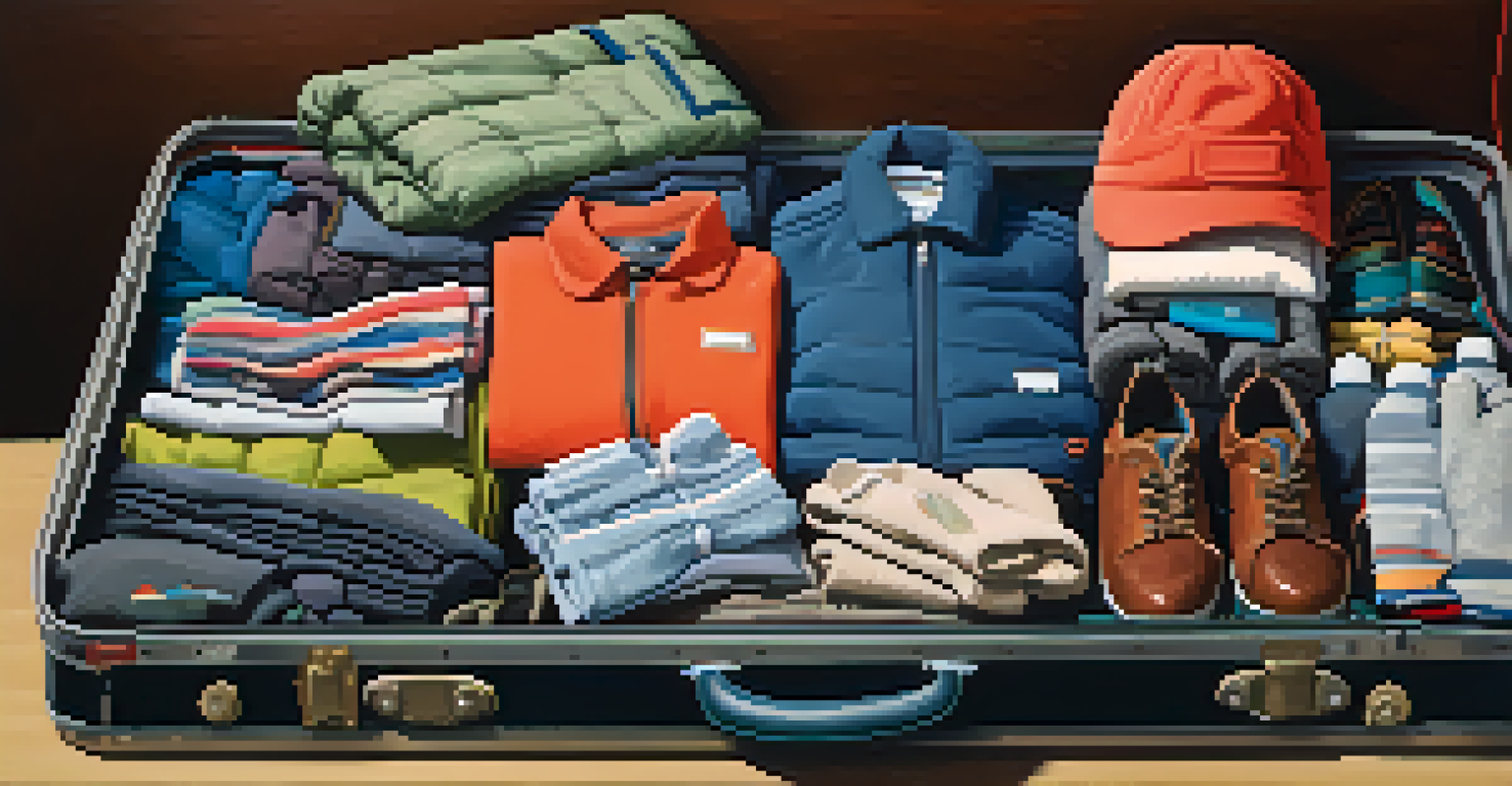How to Pack for a Ski Trip: Essential Gear and Clothing Tips

Understanding the Ski Trip Essentials Before You Pack
Packing for a ski trip can be daunting, especially if it's your first adventure on the slopes. Knowing what you need is crucial to ensure you're comfortable and prepared for a day of skiing. Start by considering the type of skiing you'll be doing, as this will impact your gear choices significantly.
There’s no such thing as bad weather, only inappropriate clothing.
For instance, if you're hitting the backcountry, you'll need more specialized equipment than if you're sticking to groomed trails. Additionally, think about the weather conditions at your destination. A well-planned packing list will not only make your trip smoother but also enhance your skiing experience.
Remember, the goal is to stay warm and dry while enjoying the stunning winter landscapes. With the right essentials, you can focus on perfecting your turns rather than worrying about whether you'll stay warm or dry.
Choosing the Right Ski Gear: What You Absolutely Need
When it comes to skiing, the right gear can make all the difference. Start with skis or a snowboard; if you don’t own your own, most resorts offer rentals. Make sure to get the right size and type based on your skill level and the kind of skiing you plan to do.

Don't forget about ski boots! Proper fitting is essential for comfort and control. They should feel snug without being painful, as this will help you maintain balance on the slopes. Additionally, consider investing in ski poles for added stability and support.
Pack Smart for Your Ski Trip
A well-planned packing list ensures you have the right gear and clothing to stay warm and dry on the slopes.
Lastly, you'll need a helmet for safety and goggles to protect your eyes from the bright sun reflecting off the snow. These items are not just accessories; they are vital for an enjoyable and safe skiing experience.
Layering Clothing: The Key to Staying Warm and Dry
Layering is a fundamental strategy for staying warm while skiing. Start with a moisture-wicking base layer that will keep sweat away from your body. Think of this layer as your first line of defense against the cold; it should fit snugly but not restrict your movement.
The best way to enjoy the slopes is to be prepared for whatever nature throws your way.
Next, add an insulating layer, like a fleece or down jacket, which traps warmth. This layer can be adjusted based on the temperature and your activity level, so choose something versatile. Finally, finish off with a waterproof and breathable outer layer to shield you from wind and snow.
By layering effectively, you can easily adjust your clothing as the weather changes throughout the day. This strategy not only keeps you comfortable but also allows for better performance on the slopes, letting you focus on the thrill of skiing.
Essential Accessories: Don't Forget the Extras!
When packing for a ski trip, accessories are just as important as your main gear. Warm gloves or mittens are essential for keeping your hands toasty while navigating the slopes. Look for waterproof options to ensure your hands stay dry throughout the day.
A ski mask or balaclava can help protect your face from the biting cold and wind. These accessories can make a significant difference in your overall comfort level. Additionally, consider packing a neck gaiter or buff, which can be pulled up over your nose and mouth when the weather turns frigid.
Layering Keeps You Comfortable
Using a layering strategy helps you adjust to changing weather conditions while skiing, enhancing your overall experience.
Lastly, don’t overlook the importance of sunscreen and lip balm. Even on cloudy days, UV rays can penetrate through the clouds and reflect off the snow, leading to sunburn. Protecting your skin is vital to enjoying your trip without painful reminders of the sun.
Packing Smart: Tips for Efficient Use of Space
Efficient packing can save you space and make your travels smoother. Start by rolling your clothes instead of folding them. This not only saves space but also helps reduce wrinkling. Use packing cubes to keep your items organized and easy to access when you arrive at your destination.
Consider using compression bags for bulky items like jackets or sweaters. These bags can significantly reduce the volume of your clothing, freeing up space for other essentials. Additionally, pack your ski gear in a separate, waterproof bag to avoid moisture getting into your clothing.
Remember to leave a little extra room for souvenirs or snacks you might pick up along the way. A well-organized suitcase can make transitions between travel and skiing seamless, allowing you more time to enjoy the adventure.
Navigating Travel Restrictions: Check Your Airline's Policies
Before you head to the airport, it’s essential to check your airline’s policies regarding ski equipment. Many airlines have specific guidelines and fees associated with transporting skis or snowboards. Knowing these details ahead of time can save you from unexpected charges at the check-in counter.
In some cases, it might be more economical to rent equipment at your destination rather than flying with it. This can also lighten your load and simplify your travel experience. However, if you choose to bring your own gear, ensure it's adequately packed and protected.
Check Airline Policies Ahead
Understanding your airline's ski equipment policies can save you from unexpected fees and simplify your travel.
Don’t forget to also check the baggage limits for size and weight. Being well-informed can help you avoid any last-minute surprises, ensuring your trip starts off on the right foot.
Final Checklist: Ensuring You Have Everything You Need
As your trip approaches, creating a final checklist can help you ensure you haven’t forgotten anything. Include all essential items: ski gear, clothing layers, accessories, and even your travel documents. This simple step can provide peace of mind and make your packing process more efficient.
Consider categorizing your checklist by type of item. For example, have separate sections for gear, clothing, and personal items. This organizational method can make it easier to see what you have and what still needs to be packed.

Finally, don’t hesitate to double-check your packing the night before your trip. A quick review can help you catch any last-minute items you may have overlooked, making sure you’re fully prepared for an unforgettable ski adventure!